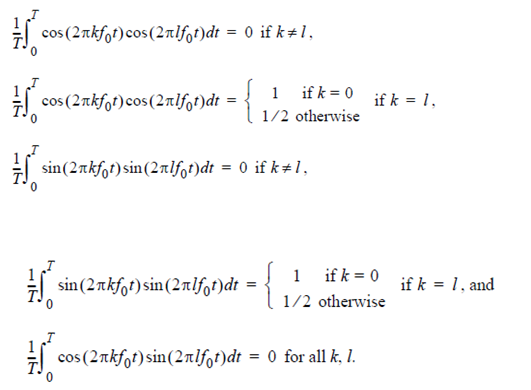SKEDSOFT
Orthogonal Function of Fourier Series: Basic Orthogonal Function used in Fourier Series are given as:
If we review the above example you will see that for each coefficients, if we wanted ak, the coefficients of the kth harmonic cosine, we multiplied the signals by cos ( 2πkf0t ). which translate the components of interest to DC where it is extrated while discarding all other terms by integrating over exactly one cycle of the fundamental frequency. Similarly if we are interested in bk, the coefficients of the kth harmonic sine, we multiply the signal by sin ( 2πkf0t ) which translate the components of interest to DC, where it is extracted while discarding all other terms by integrating over exactly one cycle of the fundamental frequency. This work because cos ( 2πkf0t ) and sin ( 2πkf0t ) are orthogonal functions, meaning that following orthogonality conditions are satiesfied by these functions.

Thus if we multiply a T - periodic signals by either cos ( 2πkf0t ) or sin ( 2πkf0t ) and integrate over one cycle, we isolate that components in the signals, contribution from all other components drop out of the results. Orthogonality implies that if there is a cos ( 2πkf0t )components in a signal, it can only be represented by ak in the Fourier series. In particular no other combination of coefficients could be used to represent that components. The same is true for a sin ( 2πkf0t )component and bk. Thus orthogonality implies that the Fourier series of a waveform is unique.